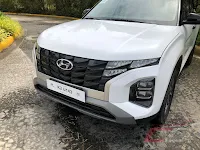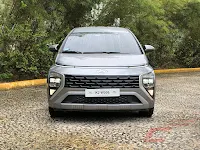The Creta and Stargazer seem like they’ve got nothing in common. Sure enough, look at them and except for the stylized “H” logo at the front, there’s almost no family resemblance. Yet, underneath, these two share the same powertrain and platform. The most vital ingredients to any new car, Hyundai has built one so flexible that it’s able to cater to vastly different audiences very well.
The design briefs for these two vehicles couldn’t have been more opposite. The Creta battles in the B-segment SUV category, going up against the likes of the Honda HR-V and Toyota Corolla Cross, and to some degree, the hybrid Nissan Kicks. Seen as a replacement to the traditional compact sedan, these have become the aspirational starter family car. They’re also for the upwardly mobile, those with burgeoning careers and increasing paychecks.
For that, the Creta has to look good, and to a large degree, they’ve nailed it. It’s best viewed from the front where it shows its fashion forward design thanks to the plate armor-like grille (Hyundai calls it, Parametric Jewel) and hidden LED DRLs. Over to the side, the profile is more generic crossover (function over form, after all), but at least the two-tone body color cuts a more flattering figure backed up by athletic looking 17-inch alloy wheels. The rear is more incongruous with the oddly-shaped taillight, but Hyundai’s constant experimentation shows that lighting is integral to their design language.
Meanwhile, the Stargazer’s form is dictated more by its requirement to ferry seven in comfort. Because of that, things like a tall roofline are a must. However, Hyundai’s offered its own twist on things by giving it a one-curve design where the stubby hood, sharply-raked windshield, and roof all seem to come together seemingly in one pen stroke. This has led to a class-leading co-efficient of drag (0.32). On top of that, Hyundai’s mastery of lighting elements is on full display once more with the full-width LED treatment for both the front and back. Like the Creta, the rear is controversial with the H-shaped taillight cluster, but again, it’s refreshing and different.
Inside, both the Stargazer and Creta dip heavily into the Hyundai parts bin, but just like their differing exterior designs, the interior execution is different from each other. There are general similarities, like the way the seats are mounted, how the pedal box on both vehicles are the same, and how both have control banks left over from their transition from right- to left-hand drive vehicles (steering wheel switches, AC controls, and infotainment controls to name three). Nonetheless, it’s clear that the Stargazer prioritizes space, while the Creta goes for individuality.
The Stargazer reduces the dashboard’s bulk by going for a flat, horizontal motif. This was done to carve out more storage spaces around the cabin, but likely, it was also done to improve the visibility. However, as it stands, shorter drivers will have difficulty looking out because the hood line simply disappears from view. Couple that with the deep dashboard and sharply raked A-pillars, and it’s pretty hard to judge the front clearance. Forward parking sensors or a front camera could have been of help, alas those features aren’t available. The design compromise here has also led to one of the oddest gauge clusters ever. The integrated binnacle, which houses both the driver’s display and infotainment system could have worked if Hyundai opted for larger screens. As it stands, the thick bezels don’t exactly look great. The gauges aren’t blocked by the steering wheel, but the display could have been executed better (not a fan of the digital rev counter).
On the other hand, the Creta’s interior is quite nice; better than its B-segment rivals, most certainly. The unique black/cognac brown colorway helps, but the overall execution from its crisp displays—10.25-inch digital display for the driver and 8-inch touchscreen for the infotainment—are nothing short of perfection. Plus, this time around, visibility is great, and the ergonomics are top-notch.
The Creta goes from strength to strength when it comes to its on-road dynamics. As a crossover, you don’t expect much in terms of handling, but this one has managed to school the base HR-V S in that respect. In the route around the hills of Cebu, it feels right on the money. It’s easy enough to get comfortable, maneuvering is easy, and on-road refinement is hard to fault. The outputs of its engine—a normally-aspirated 1.5-liter engine are nothing extraordinary, but the IVT or Intelligent Variable Transmission (basically a CVT with built-in shift logic) makes it an adept road warrior. It doesn’t have any of the usual slip or droning sounds common with gearless transmissions increasing long distance touring comfort, while still returning a commendable 9.91 km/L throughout this drive.
Onto the Stargazer, this 7-seater MPV veers more towards the softer side of the handling equation. It’s also mighty quiet with good levels of NVH despite its positioning as an entry-level MPV. Yet, it can be a tidy handler if pushed thanks to its precise steering and responsive brakes. It’s not designed for tackling twisties, but it can be fun to push around. Its engine, shared with the Creta, makes more power than the Xpander or Avanza/Veloz. It also produces the most torque as well. Couple that with a lower curb weight and better aero, it nets out 9 km/L. As an added treat, there are selectable drive modes too, but you can just leave things in Smart and let the car do the rest.
Under its previous distributor, safety was a weak point for Hyundai, but with the Creta and Stargazer, they’re doing their best to catch up. Driven in their highest trims—both of these vehicles are equipped with Hyundai Smart Sense—their brand of advanced driver assist. There’s little need to go into detail here, but let’s just say it works; it prevented a potential accident during this drive when a couple of kids darted out in front of the convoy. The Stargazer, in this case, detected them and applied the brakes all without the driver intervening. The lane departure warning was more nannying, but that can be disabled by going through the car’s menu.
Admittedly, the seat time on both vehicles was quite short because driving duties were split between two cars and two drivers. Regardless, it serves as a delectable appetizer of what Hyundai is now capable of. Entering the two most fiercely contested segments in the country—the B-segment SUV and compact MPV segment—takes cajónes, but if they want to achieve any respectable sales volume locally, they need to. And in that respect, the Creta and Stargazer shows they’re on form. Design-wise, the Creta and Stargazer may not have a unified family look, but dive deep into the details and it shows they know their respective markets very well. Ultimately, it shows their Progress for Humanity vision—a vision where their cars are designed and engineered around what matters: the people.






















Stargazer price is compettitive specially the TOTL with 6 airbags and adas.however creta is pricy with just 2 airbags on all variant.
ReplyDeleteIs that Hyundai IVT more reliable than the competitor's CVT?
ReplyDeleteAsk yourself this. How many years has it been since the IVT was released. There's your answer.
DeleteHyundae ph should decreased the price of creta, its very pricy vs its competitors. Corolla cross 1.8G with 7 airbags is just 1.312m
Delete